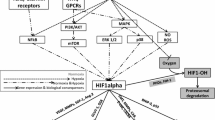Summary
Malignant brain tumours contain focal hypoxic areas that may increase their resistance to chemotherapy and radiotherapy. Following surgical excision, the peri-tumoural area will contain residual viable tumour cells, and this area is therefore the logical site for subsequent therapy. The new bioreductive agents are metabolized under hypoxic conditions to produce a cytotoxic species. Peroperative peri-tumoural micro-polarographic measurments have been made to establish the oxygen environment of this region and to determine whether the hypoxic conditions might allow for bioreductive drug activation. The micro-polarographic method is described and results are presented for “normal” white matter (8 patients) to allow comparison with peri-tumoural brain (8 patients) before and after removal of the tumour. The results suggest that peri-tumoural brain (median pO2 10.8 mmHg, 18% pO2 < 2.5 mmHg) is markedly hypoxic in comparison with the “normal” brain (median pO2 15.3 mmHg, less than 2% < 2.5 mmHg), and that surgery improves peri-tumoural oxygenation towards that of the “normal” white matter. It is concluded that the hypoxic peri-tumoural area can provide the conditions under which bioreductive agents may be activated.
Access this chapter
Tax calculation will be finalised at checkout
Purchases are for personal use only
Similar content being viewed by others
References
Bloom HJG (1982) Intracranial tumours: response and resistance to therapeutic endeavours 1970–1980. Int J Radiation Oncol Biol Phys 8: 1083–1113
Bush RS, Jenkin RDT, Allt WEC, Beale FA, Bean H, Dembo AJ, Pringle JF (1978) Definitive evidence for hypoxic cells influencing cure in cancer therapy. Br J Cancer 37 [Suppl 3]: 302–306
Cruickshank GS, Rampling R, Cowans W (1992) Direct measurement of the pO2 distribution in malignant brain tumours. In: Vaupel P et al (eds) Proceedings of the International Society on Oxygen Transport to Tissue XV. Adv Exp Med Biol, in press
Fleckenstein W, Schaffler A, Heinrich R, Petersen C, Gunderoth-Palmowski M, Nollert G (1990) On the difference between muscle pO2 measurements obtained with hypodermic needle probes and with multiwire surface probes (Parts 1 and 2). In: Ehrly AM et al (eds) Clinical oxygen pressure measurement II. Blackwell, Ueberreuter, Berlin, pp 256–278
Gray LH, Conger AD, Ebert M, Hornsey S, Scott OCA (1953) Concentration of oxygen dissolved in tissues at time of irradiation as a factor in radiotherapy. Br J Radiol 26: 638–648
Grote J (1960) In: Schmidt RF, Thews G (eds) Physiologie des Menschen, 23rd edn. Springer, Berlin Góttingen Heidelberg, p 635
Lubbers DW (1969) The meaning of the tissue oxygen distribution curve and its measurement by means of Pt electrodes. Prog Resp Res 3: 112
Schultheiss R, Leuwer R, Leniger-Follert E, Wassmann H, Wullenwever R (1988) Tissue pO2 of human brain cortexmethod, basic results and effects of pentoxifylline. Angiology 38: 221–225
Whittle IR (1992) The biology of glioma. In: Teasdale GM, Miller JD (eds) Current neurosurgery. Churchill Livingstone, Edinburgh, pp 255–284
Workman P, Walton MI (1991) Enzyme-directed bioreductive drug development. In: Adams GE, Breccia A, Fielden EM, Wardman P (eds) Selective activation of drugs by redox processes. Plenum, New York, pp 173–191
Author information
Authors and Affiliations
Editor information
Editors and Affiliations
Rights and permissions
Copyright information
© 1994 Springer-Verlag
About this paper
Cite this paper
Cruickshank, G.S., Rampling, R. (1994). Peri-Tumoural Hypoxia in Human Brain: Peroperative Measurement of the Tissue Oxygen Tension Around Malignant Brain Tumours. In: Ito, U., et al. Brain Edema IX. Acta Neurochirurgica, vol 60. Springer, Vienna. https://doi.org/10.1007/978-3-7091-9334-1_101
Download citation
DOI: https://doi.org/10.1007/978-3-7091-9334-1_101
Publisher Name: Springer, Vienna
Print ISBN: 978-3-7091-9336-5
Online ISBN: 978-3-7091-9334-1
eBook Packages: Springer Book Archive




